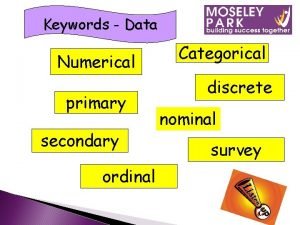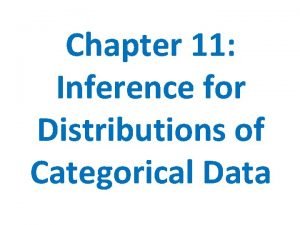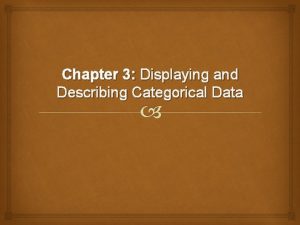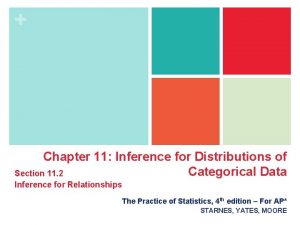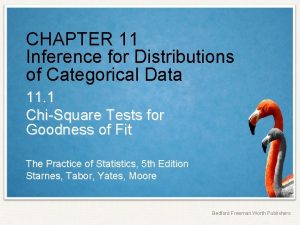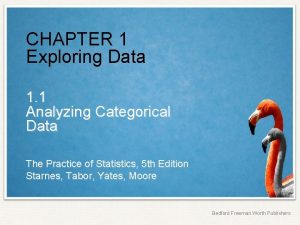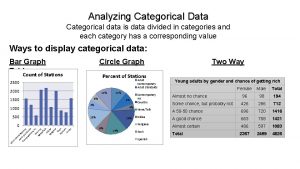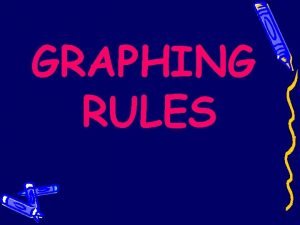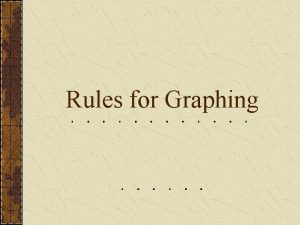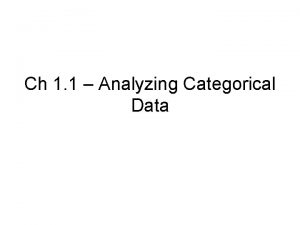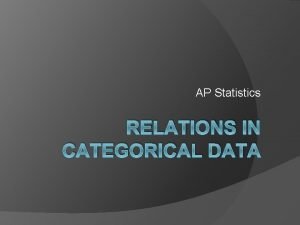Graphing Categorical Data CHAPTER 2 The Three Rules










- Slides: 10

Graphing Categorical Data CHAPTER 2

The Three Rules of Data Analysis 1. Make a picture—things may be revealed that are not obvious in the raw data. These will be things to think about. 2. Make a picture—important features of and patterns in the data will show up. You may also see things that you did not expect. 3. Make a picture—the best way to tell others about your data is with a well-chosen picture.

Two Types of Graphs for Categorial Data § BAR GRAPHS (CHARTS) § PIE GRAPHS (CHARTS)

Bar Graphs Frequency Bar Graph Relative Frequency Bar Graph n Displays the counts �Displays the for each category proportion of counts Notice they are the same graph except the vertical axis

Pie Graphs � When you are interested in parts of the whole, a pie chart might be your display of choice. � Pie charts show the whole group of cases as a circle. � They slice the circle into pieces whose size is proportional to the fraction of the whole in each category. � They can be displayed as a frequency pie chart (counts) or a relative frequency pie chart (%).

Think before you draw! � Our first rule of data analysis is make a picture. But what kind of picture? � Knowing when to use each type of graph is a critical first step in data analysis. � That decision depends in part on what type of data we have. � It’s important to check that the data are appropriate for whatever method of analysis you choose. � Before you make a bar chart or a pie chart, always check the categorical data condition: the data are counts or percentages of individuals in non-overlapping categories.

Don’t violate the Area Principal While some people might like the pie chart on the left better, it is harder to compare fractions of the whole, which a flat pie chart does easily.

Keep it honest This plot of the percentage of highschool students who engage in specified dangerous behaviors has a problem. Can you see it? • It doesn’t add to 100% because of the overlapping categories • The Area Principal is violated because the blue section looks less than half

Requirements of a Graph § Title your graph. Hint: This is the most missed item on the first test! § Labeled each axis of a bar graph. § Label each sector of a pie graph. § Label and use appropriate scale. § Obey the Area Principal. § The widths of each category in a bar graph are equal. § The heights in a bar graph should match the scale of the data. § All sections in a pie graph should total 100%. § Each section in a pie graph should match the scale of the data.

Homework Week 1 üLog into Canvas Course üRead syllabus üConnect to My. Lab & Mastering (Pearson) following directions from syllabus üComplete HW Chapter 1 üRead Chapter 2 PP üComplete HW Chapter 2 Bring your graphing calculator to class!
 What are secondary keywords
What are secondary keywords Biologists wish to cross pairs of tobacco plants
Biologists wish to cross pairs of tobacco plants Categorical data displays
Categorical data displays Chapter 11 inference for distributions of categorical data
Chapter 11 inference for distributions of categorical data Chapter 11 inference for distributions of categorical data
Chapter 11 inference for distributions of categorical data Categorical imperatives examples
Categorical imperatives examples What statistical test for categorical data
What statistical test for categorical data Bivariate categorical data
Bivariate categorical data Categorical data classification
Categorical data classification Categorical hypothesis testing
Categorical hypothesis testing Analyzing categorical data
Analyzing categorical data
